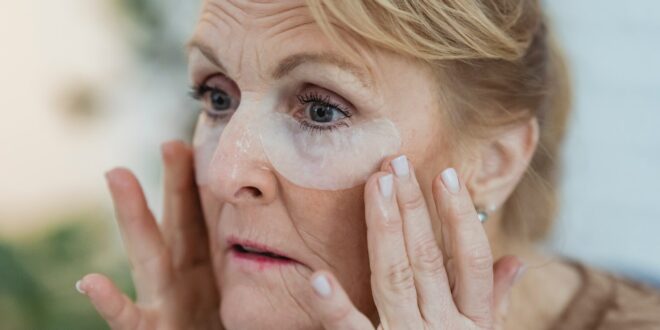Extract from Melanie Grant’s book ‘The Modern Guide to Skin Health’
In some ways, caring for our skin in our 60s and beyond is simpler than at any other time in life, despite the potential for it being afflicted by more conditions (pigmentation, sun damage, redness) than in our youth. Why is it so simple? Well, those hormone fluctuations are starting to settle, lines and wrinkles have already formed, and you likely really understand exactly what works and what doesn’t for your own skin. This is the decade when many of my clients often feel, finally, settled in their skin and confident about their image. The days of being concerned about a single fine line or wrinkle are over and, ideally, this is the time when embracing your own natural beauty takes charge.
Seeing women in this age group embrace their face and body exactly how they look is one of the greatest joys I have in my career. It’s a lesson to us all, and it’s important to remember that as you enter your 60s and beyond, your greatest gift to those younger than you is to lead by example and show off exactly how gorgeous the ageing process can be. Your wisdom is shown in your face, and personally, I wouldn’t change that even if I could.
Post-menopausal skincare follows a pretty tried-and-tested formula. Once things have settled on the hormonal front, the skin reaches a point where collagen and elastin production is virtually nil, meaning a great skincare routine is the only thing that’s going to keep you glowy. For me, maintaining the skin’s texture, clarity and radiance are the key elements of having good skin health beyond 60. Completely obliterating lines and wrinkles is not the objective. Those lines aren’t going anywhere. Instead, the focus should be on embracing them as we work on other more tangible and noticeable aspects of the skin’s appearance, including its vibrancy and any other concerns like redness or pigmentation.
THE DO’S AND DON’TS OF SKINCARE IN YOUR 60s
DO Embrace the ageing process. Work on improving the texture and luminosity of your skin, as these are the most noticeable elements in older skin, as opposed to wrinkles.
DON’T Try and cover up lines by injecting copious amounts of filler. The older we get, the more noticeable injectables can become, so approach these treatments with caution.
DO Use products suited for ageing skin, ideally with moisture-enhancing ingredients.
DON’T Be afraid of serious treatments to target spots and pigmentation. If you can’t splurge on self-care now, when can you?
A BASIC SKINCARE PLAN
The older we get, the more we have to add to our routine in order to get results. For me, it has always been about moisture. Setting skin conditions aside for a second, moisture (both water and oil) is the lifeline of great skin. Plumping our cells up by pumping them full of hydration is essentially the key to unlocking vibrant, luminous skin. Using that mindset, look for hydrating properties in every product you use, from a simple cleanser to your night cream, which by this stage should be nice and thick.
Lots of brands will claim to have found the ‘cure’ for ageing, but my approach is to always look for products suited to dry skin. While no 20-year-old is going to have the same routine as someone in their 60s or 70s, there are products that work to combat dryness across the generations, so don’t be fooled by smart marketing tactics. Instead, ask questions to salespeople, do your research and look at the key ingredients so you know what to avoid (see page 28 for a reminder of how some ingredients can be listed).
IN THE MORNING
- Hydrating cream cleanser
- Antioxidant serum
- Eye cream
- Moisturiser
- SPF50 sunscreen
IN THE EVENING
- Oil cleanser
- Gentle, hydrating cleanser
- Hydration or treatment serum
- Retinol serum
- Retinol eye cream
- Rich night cream
- Face oil
Retinol is a fantastic treatment for ageing skin. It helps to promote cell turnover faster than our body can naturally, which means it can help improve the overall texture and clarity, as well as help reduce the appearance of finer lines. Retinol should be used only at night but is great to layer underneath a night cream to work while you sleep. Also, look for an eye cream that includes retinol for night time.
In the morning, vitamin C is great for brightening and boosting your SPF (not to be forgotten, ever, at any age!) in fighting free-radical damage from the sun or pollution, among other things. Targeted vitamin C products are among my favourites to recommend to clients, but vitamin C can also be found in rosehip and marula oil for an extra layer of hydration.
A hydrating serum with an ingredient like hyaluronic acid can help bring a shine back to ageing skin thanks to hyaluronic acid’s ability to hold 1000 times its weight in water. However, make sure you’re pairing it with a good-quality moisturiser that includes lots of lipids and oils to help lock these ultra-hydrating abilities into the skin’s barrier.
Peptides are another great ingredient to use on ageing skin. Palmitoyl Oligopeptide is great for collagen production, while Palmitoyl Tetrapeptide-7 can help lessen inflammatory responses and calm the skin.
Ingredients can be confusing, and with so many products out there and more coming on the market all the time, it’s always best to ask for advice that’s specific to your skin type. One of the benefits of seeing the same therapist regularly for simple facials or more targeted treatments is that you’ll be able to ask their opinion on products and how those might suit your particular skin. A good therapist will advise you on products from other brands and stores and should be able to assist based on your budget, too. Reading a book like this is also going to help you build the foundations and knowledge of what to look for, so you’re already off to a great start!
COMMON CONDITIONS AND CONCERNS
- Redness pops up more as an issue because as we age, our skin thins naturally, and exposure to the sun can speed up this process. This thinning can result in broken capillaries, which in turn create those red patches under the skin that are sometimes called spider veins. While there’s no way to reverse this damage, it can be avoided by staying out of the sun (or using sunscreen diligently when in the sun) and trying to limit alcohol intake, which can enlarge our capillaries and cause them to burst. Skin plumping and moisture-filled products can also help boost collagen production in the skin, giving it a thicker outer layer to help cover capillaries.
- Pigmentation is frequently a concern at this age, especially in those who didn’t wear sunscreen in their youth. Sun-induced pigmentation is incredibly common, especially in Australia, and it’s something I encounter regularly. Fraxel and IPL are the two most effective ways of treating this sort of pigment (steer clear of it for melasma, hormonally induced pigment). However, Fraxel and IPL aren’t advised for women with darker skin. For topical treatments, the ingredients ascorbic acid and kojic acid can be helpful in reducing the appearance of pigment, and anti-pigmentation professional peels can help at a deeper level than topical creams.
- Congestion is likely nowhere near as bad as it was in younger years. In fact, that’s one of the best things about ageing skin: a lot of what might have concerned you in your youth doesn’t bother you any longer! Conditions like cystic acne are all but gone, but congestion can still appear in these post-menopausal years, and some form of congestion is common throughout our lives, even when our skin is drier. Target congestion with chemical exfoliants, such as an AHA or BHA serum, which can be applied at night, but ensure you’re only applying that serum to the affected area so as not to dry out the rest of your skin. Clay masks can also help draw out impurities, but again, apply only to the affected areas. Continue to moisturise congested zones, as even dry skin can still be afflicted with clogged pores.
- Saggy skin is a by-product of fat loss in our skin’s top layer as we age. Coupled with a lack of collagen and elastin, sagging or slumping skin is common in this decade. There’s no quick fix, but regular exercise – even facial exercise or tools like gua sha (page 140) – as well as taking supplements that include collagen can encourage the skin to fill out and stimulate the facial muscles to get working.
SUN PROTECTION AND THE SKIN
Just because you didn’t protect your skin from the sun in your youth doesn’t mean all hope is lost.
It’s never too late to start using sunscreen, and when used daily can make significant impacts on skin health, even later in life. As someone who lives near a beach in Sydney, I’ve seen first-hand what happens when sun protection is completely ignored – both on the sand on elderly skin that is rough, saggy and pigmented, but also with friends and family who have developed skin cancers later in life. The lesson: it’s never too late to start using sunscreen, every single day. Forever!









Deb Jones - 2 years ago
Some great advice. Thank You.